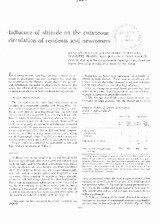Mostrar el registro sencillo del ítem
Influence of altitude on the cutaneous circulation of residents and newcomers
| dc.contributor.author | Durand, Jacques | |
| dc.contributor.author | Verpillat, Jeanne-Marie | |
| dc.contributor.author | Pradel, Mariette | |
| dc.contributor.author | Martineaud, Jean-Paul | |
| dc.date.accessioned | 2017-08-08T12:59:42Z | |
| dc.date.available | 2017-08-08T12:59:42Z | |
| dc.date.issued | 1969 | |
| dc.identifier.uri | http://repositorio.umsa.bo/xmlui/handle/123456789/11672 | |
| dc.description.abstract | SUMMARY. Blood flow, pressure, and volume have been measured in the right hand considered as representative of a cutaneous vascular bed. Measurements have been made comparatively at sea level and at high altitude (3.750 and 4,800 m) on residents and newcomers. The results show an increase of the tone of both resistance and capacitance vessels at high altitude. The changes are more marked when the skin temperature is higher, that is, when the cutaneous circulation is increased. Extrapolating these results to the whole skin area, one can conclude that the cutaneous circulation acts as a blood reservoir during the circulatory adjustments caused by high-altitude hypoxia. | es_ES |
| dc.language.iso | en | es_ES |
| dc.publisher | Federation Proceedings | es_ES |
| dc.subject | ALTURA | es_ES |
| dc.subject | CIRCULACIÓN CUTÁNEA | es_ES |
| dc.title | Influence of altitude on the cutaneous circulation of residents and newcomers | es_ES |
| dc.type | Article | es_ES |

